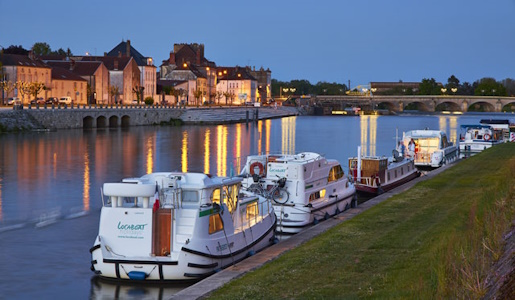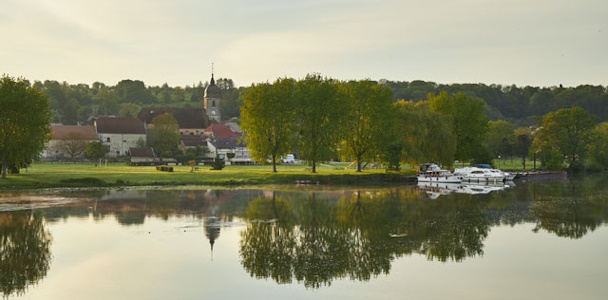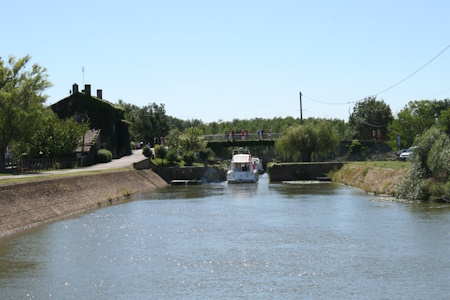The Saône, a majestic river (so calm that Julius Caesar wondered which way it flowed when he first saw it) can be considered the center of the river world.
Center of the spiritual world as well with Cluny and Taizé; center of the wine world with Chardonnay, Gamay, Pommard, Beaune, center of the gastronomic world with Bocuse, Bernard Loiseau, Troisgros restaurants, Bresse chickens, Charolais beef, the Saône Valley is practically the geographic center of the world. Very close to the Mediterranean, a few hours from Germany or Switzerland, a suburb of Paris, this transit region will be very easy for you to access whether by car, train, plane or boat.

Plus, no license required!
The Saône Valley is part of the destination Burgundy Franche-Comté that we offer for your next river cruise.
The Saône Valley, an ideal basin for river tourism, is very complementary and gives access to Franche-Comté and the Burgundy Canals where we also offer a very large selection of license-free habitable boat rentals, barges, and Penichette®.
Must-see spots on the Saône by boat
- Bresse chickens, Charolais beef, Franche-Comté cheeses, Dijon mustard, pike, zander, crayfish, and other products from its many rivers, all prepared or accompanied by the world's most prestigious wines, have made Burgundy the capital of gastronomy. Large and small restaurants await you, you will be spoiled for choice.
- The Saône Valley, far from major industrial centers but open to the outside world thanks to its many communication routes, has managed to remain rural and keep its many villages and small towns while evolving and equipping itself with the most modern facilities. You will be warmly welcomed and will not lack anything.
It is certainly one of the regions where you will have a wide range of activities during your cruise.
- Inhabited since ancient times, you will find traces of all the civilizations that have built Burgundy: Azé and Solutré for early settlements, Alésia and Bibracte for the Gauls; Cluny, Cîteaux, and Vézelay, one of the starting points of the mythical Saint-Jacques-de-Compostelle route classified as a UNESCO World Heritage site. Famous castles have housed great figures like Vauban, Colette, Lamartine, Mme de Sévigné who have left their mark on Burgundian culture.
Some stops on your cruise on the Saône
The Saône
375 km of navigable waterway - 25 locks. From Corre to St Symphorien sur Saône, the upper part is commonly called "Petite Saône". See region Franche-Comté.
St Jean de Losne. True capital of river navigation in Burgundy.
St John the Baptist Church, the Mariners' House, the Cannons, the King's Lodge.
Verdun sur le Doubs. River and geographic crossroads, Verdun sur le Doubs has undergone many invasions due to its location.
Today a calm city, Verdun offers a choice gastronomic stopover away from the Saône.
Chalon sur Saône. City of art and history famous for its way of life and secular traditions. Chalon sur Saône is an ideal destination for gourmets, oenophiles, and lovers of art and historical heritage.
Photography Museum, St Vincent Cathedral, St Laurent Hospital, and the old town.
Tournus. City stretching along the banks of the Saône between the Bresse plain and the Mâconnais hills. Tournus, a gem of Romanesque art, its low-pitched roofs already announce the South. It is one of the most visited sites in Burgundy.
St Philibert Abbey, St Laurent Chapel, St Madeleine Church, Town Hall.
La Truchère. At the intersection of the Saône and the Seille river.
By bypassing an island called the Corne de Vachon, the Seille river forms two arms, but only the south arm is navigable. North of this village, a marked trail will allow you to observe the flora and fauna specific to the Seille's wet plains.
Mâcon. One of the oldest cities in France. It was terribly damaged by the religious wars.
The towers and narthex of the former St Vincent Cathedral, the 16th-century wooden house with its risqué sculptures, the 11th-century St Laurent bridge, the Sennecé hotel, a Renaissance gem that houses the Lamartine museum.
Saint Romain des Îles. This village offers boaters a charming nautical stop.
From this stop, you can discover the wine hamlet and the Touroparc animal park.
Belleville. Between the Beaujolais hills and the Saône, 30 minutes from Lyon, beautiful landscapes, conviviality, and rich heritage. Hills with magnificent panoramas, wine villages, and large towns. St-Jean-d'Ardières and Belleville, economic, administrative, and tourist heart of the region.
The old Hôtel-Dieu whose great hall has been restored to its original state. You will find a beautiful 18th-century pharmacy there.
Villefranche sur Saône. This city founded in 1140 by Hubert de Beaujeu is now a sub-prefecture and the capital of Beaujolais. To discover an exceptional architectural heritage from the 17th and 18th centuries, just follow the Rue Nationale. You will discover amazing houses often with inner courtyards and Lyon-style staircases.
Trévoux. This city was the capital of the principality of Dombes, where a sovereign parliament sat. It was therefore independent until 1762.
The Parliament Palace, the remains of the old feudal castle from the 10th and 13th centuries, the hospital and its old apothecary with a remarkable collection of Gien and Nevers faience pots.
Lyon. Arriving in Lyon via the Saône is a unique experience not to be missed. First, you pass the picturesque Île Barbe, a popular walking spot for Lyon residents. Then, you discover the most beautiful districts of the third largest French city in complete tranquility because, despite its importance, river traffic is relatively calm and moorings numerous and easily accessible.
At the confluence of the Rhône and the Saône, Lyon has been nestled for over two thousand years against the hills of Fourvière and Croix Rousse. A crossroads of several civilizations.
Parc de la Tête d'Or: A public park where you can walk, visit the zoo, the four rose gardens, the eight-hectare botanical garden including 6500 m² of greenhouses... all for free: Lyon is considered the capital of gastronomy. It combines Bresse and Charolais livestock, Dombes game, fish from Savoy lakes, and wines from the Rhône Valley, Beaujolais, and Burgundy. (try the small Lyonnais bouchons).
Textile and Decorative Arts Museum, Printing Museum, Contemporary Art Museum, Miniature and Cinema Sets Museum, Lyon Opera, a jewel of light, the slopes of Croix Rousse, the Lyon canuts district, Hôtel-Dieu, the Stock Exchange Palace, ...

The Seille
40 km of navigable waterway with 4 manual locks from La Truchère to Louhans. For the first lock (at La Truchère) a lock keeper will be there to help you.
Louhans. The main curiosity of the city is its grand street lined with 147 arcades from the Middle Ages and the 16th century as the most active trading and craft center in the region.
In the hospital, it is possible to visit the pharmacy richly decorated with woodwork, where there is an important collection of pots.
The local specialty is Bresse poultry. Every Monday morning is enlivened by a major livestock fair, but poultry hold a predominant place.
L'Indépendant newspaper museum. Bailli's House, Grenette Street, St-Pierre Tower.
Branges. River stop with the Bourgchâteau mill located a few meters away.
In the mill, there is a restaurant and a small shop.
Loisy. River stop.
Cuisery. One of the four "book villages" in France. About ten bookstores specializing in old books offer all kinds of works. The first Sunday of each month, there is a book market.
Eden Center (nature discovery and environmental education): 700 meters on foot from the river stop.
La Truchère. At the intersection of the Saône and the confluence of the Seille river.
By bypassing an island called the Corne de Vachon, the Seille river forms two arms, but only the south arm is navigable. North of this village, a marked trail will allow you to observe the flora and fauna specific to the Seille's wet plains.
In the village, you can admire a very old calvary that bears the statuette of Saint Nicholas and Saint Baptist and enter the church to contemplate a painting of St Roch, patron of the parish.

Pont de Vaux Canal
The canal was opened to navigation in 1844. Decommissioned in 1954, it was reopened forty years later, in 1994, for pleasure navigation. The canal follows the Reyssouze river for a distance of 3.5 km to the town of Pont-de-Vaux.
This land of rivers and plains is distinguished by its large farmhouses, sometimes built of cob and half-timbering. It is also known for its high-quality agricultural products, including the famous Bresse chickens.
Bresse farms with Saracen chimneys, Sermoyer sand dunes (natural site).
Pont de Vaux. A very dynamic rural town.
Antoine Chintreuil Museum (fine arts collections, local history, regional ethnography).
Photos: Locaboat.